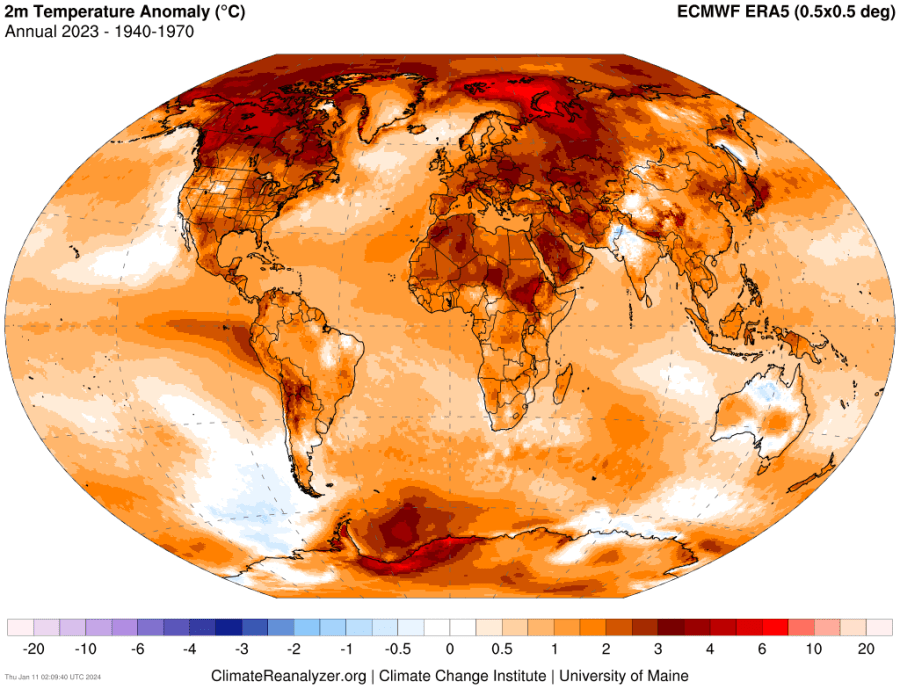TAMPA, Fla. (WFLA) — To say 2023 was the warmest year on record, would not be sufficient to describe just how freakishly warm it was.
Going into the year, scientists knew there was some chance it would be a near-record warm year for the planet due to the evolution of El Niño. But the heat was so extraordinary it was shocking even for trained meteorologists and climate scientists.
The average temperature of the entire globe finished the year 2.7 degrees F (1.48 C) above the pre-industrial average – .31 degrees F above the previous record set back in 2016. In the image below, the red indicates areas where the 2023 temperature was above the mid-1900s mean – basically everywhere.

This image below is another way to visualize just how off-the-charts 2023 was compared to all other years. The image shows how global temperatures gradually increase year by year due to human-caused climate change, and then how 2023 just jumps off the chart.

It was so warm in 2023, that the Earth spent nearly half the year above the +1.5 degrees C threshold set by the Paris Climate Agreement and two days were above the +2 degrees C threshold, as seen in the graphic below.
For background, the Paris Climate Agreement was signed in 2015 by all nations, to limit warming to 1.5 or 2 degrees Celsius above the pre-industrial average (1850-1900).

While many days were above +1.5C, the average for the year fell just short of +1.5C. For a real breach of the Paris Agreement to occur +1.5C would have to be maintained for several years. And while 2024 is likely to be as warm, or even warmer than 2023, the +1.5C will not likely be sustained once El Niño is gone. A true breach of +1.5C will likely occur in the early 2030s.
Still, the point is that global temperature rise shows no signs of slowing down. Endless amounts of good intentions and greenwashing have done nothing to slow the relentless march of temperatures upward.
That extra energy in the system fueled remarkable extreme weather around the world. It’s a window into what a +1.5C world looks like – a yearly occurrence in merely a decade.
The past ten years have been the warmest 10 years on record globally, with 2023 the clear winner, if you can call it that.

So what gives? Why was the second half of 2023 so much warmer than any other year, by a landslide?
Well, the biggest factor is climate change. The baseline simply starts higher now on our heated planet, thus it is easier to reach extremes. But that does not explain why it spikes.
The second most important factor is the development of a strong El Niño starting in summer, which is precisely when temperatures jumped. Since the past three years have been cool La Niña’s – masking some of the heating – the switch to El Niño likely came with a stronger jolt than usual.
El Niño releases heat trapped in the depths of the Pacific Ocean, upward to the sea surface and atmosphere. That warms global temperatures.

Still, the numbers do not quite add up. Something else is going on and it is puzzling to even the best climate scientists on the planet. But we do have some ideas. The decrease in atmospheric pollution (aerosols) from a new 2020 shipping law likely had some impact on aiding recent warming. The eruption of the Hunga Tonga Volcano may have also played a small part, although multiple studies find that the impact was likely minimal.
The bottom line is we don’t know exactly why 2023 was so exceptional, but some scientists such as the infamous Dr. James Hansen think we are at the start of a new climate regime where planet heating is speeding up.
Perhaps the most exceptional aspect of 2023 was the degree of ocean warming. And it wasn’t just the El Niño heated Eastern Tropical Pacific. Arguably the North Atlantic was more anomalously warm. In all – as can be seen in this image below from Dr. Ed Hawkins – sea surface temperatures were far and away the warmest on record.

Most of the warming of the Atlantic Ocean can not be explained by El Niño but clearly, the Atlantic was a big reason 2023 was so warm globally. The pollution reduction (less aerosols) can help to explain some of what has been happening in the Atlantic.
In short, 2023 should be a major wake-up call to the world. We can not continue business as usual without causing irreparable damage to our climate, and thus the foundations that support life – human or otherwise – on Earth.






